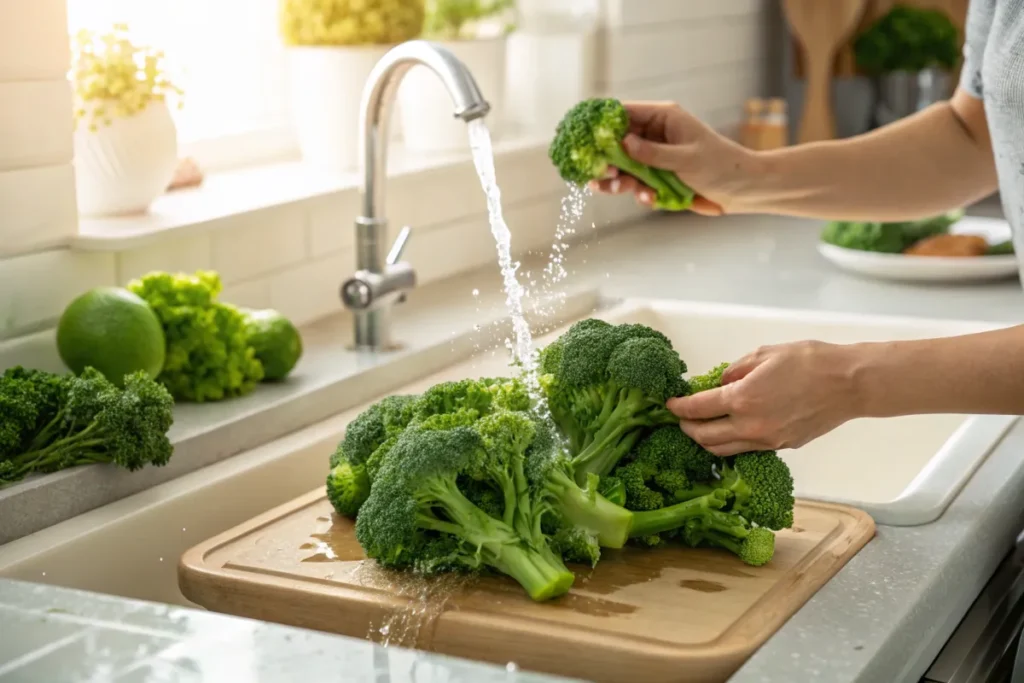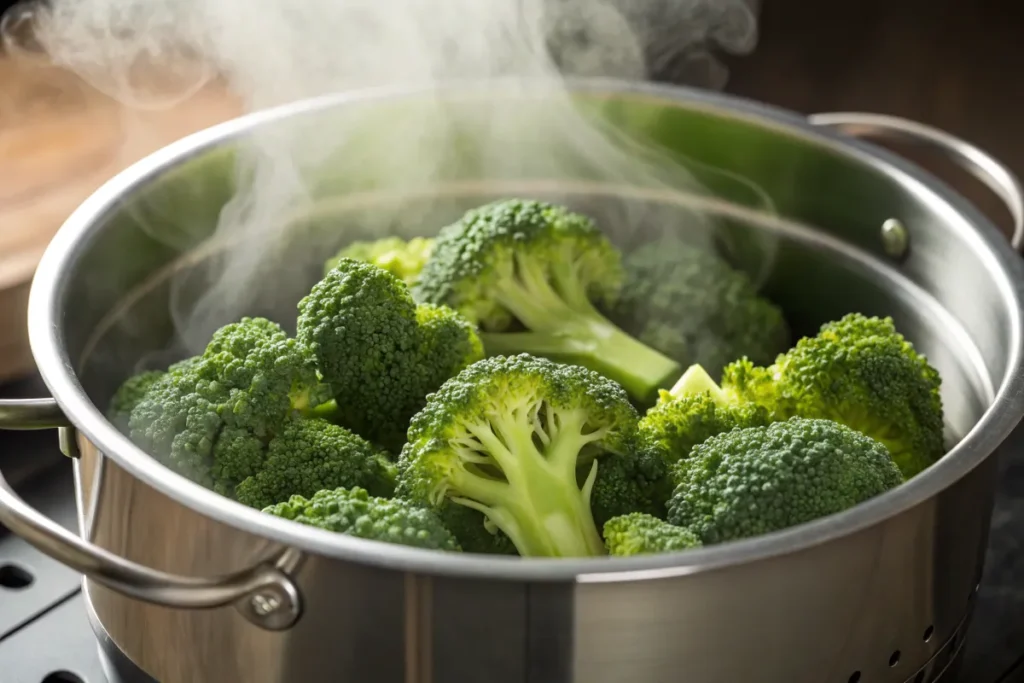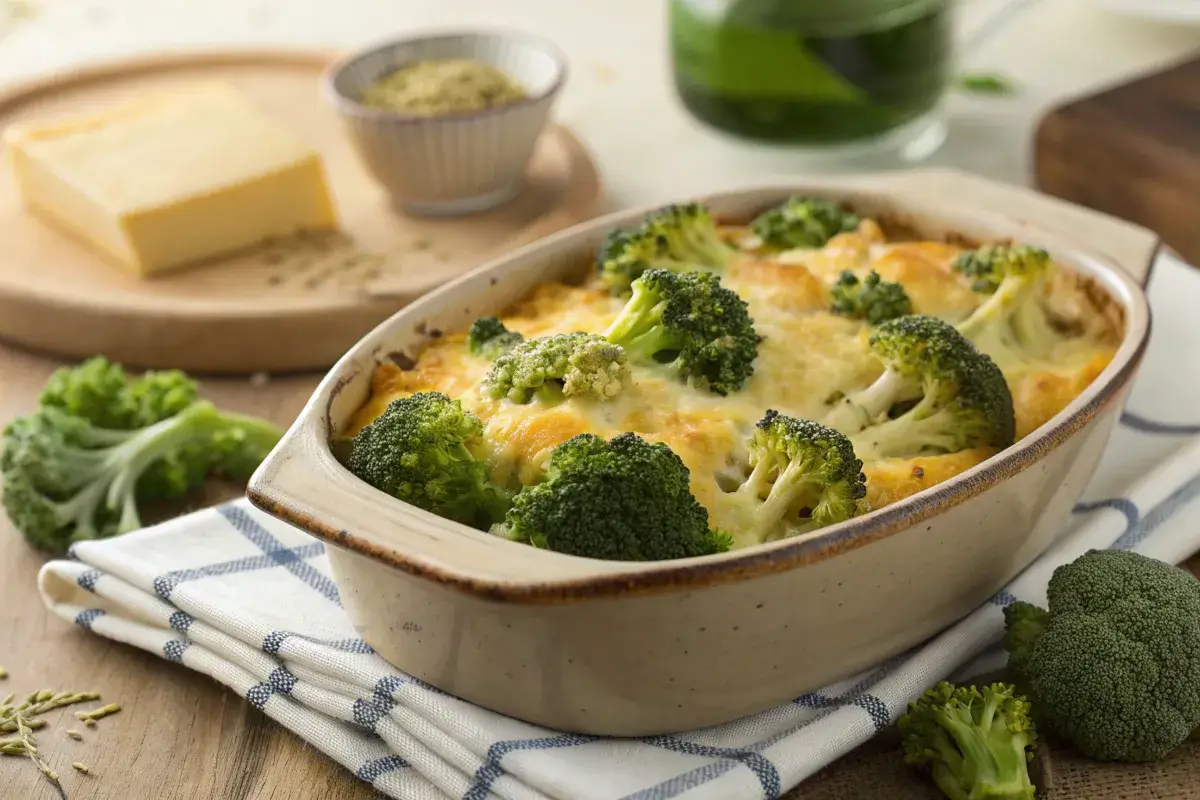Table of Contents
Introduction for Can I substitute fresh broccoli for frozen in a casserole?
When it comes to cooking up a hearty casserole, broccoli is a go-to ingredient for adding color, texture, and nutrition. But what happens if you’ve only got fresh broccoli on hand when the recipe calls for frozen broccoli — or vice versa? Can I substitute fresh broccoli for frozen in a casserole? Absolutely! Whether you’re looking to swap fresh broccoli for frozen or simply curious about the differences between the two, understanding a few key factors will ensure your dish turns out perfectly.Can I substitute fresh broccoli for frozen in a casserole?
Using fresh broccoli in a casserole can add a delightful crunch and vibrant flavor, while frozen broccoli offers convenience and a softer texture. But does it affect the cooking process? Should you blanch fresh broccoli first, or adjust baking times? In this guide, we’ll dive into the fresh vs frozen broccoli in casserole debate and show you exactly how to make the swap. Plus, we’ll share expert tips to elevate your casserole game with either option. Let’s get started
Part 1: Understanding the Basics – Can I substitute fresh broccoli for frozen in a casserole?
Why Swap Fresh Broccoli for Frozen?
Whether you’re out of frozen broccoli or prefer the crispness of fresh produce, making the switch is easy. Fresh broccoli in a casserole brings a brighter color and a firmer texture, while frozen broccoli offers unbeatable convenience—no chopping or washing needed.
One advantage of using fresh broccoli is having complete control over the cooking process. Since frozen broccoli is blanched before freezing, it softens quickly when baked. Fresh broccoli, on the other hand, allows you to customize the texture—whether you want a slight crunch or tender, melt-in-your-mouth goodness. If you’re debating whether to swap fresh broccoli for frozen, consider how much time you have and the texture you prefer in your dish.
Nutritional Differences Between Fresh and Frozen Broccoli
When it comes to nutrition, the differences between fresh vs frozen broccoli in a casserole are minimal. Frozen broccoli is flash-frozen at peak ripeness, preserving its vitamins and minerals. Fresh broccoli, while slightly more vibrant in taste and texture, can lose some nutrients if stored in the fridge for several days.
That said, if you prioritize natural freshness, fresh broccoli wins for its unprocessed quality—just wash, trim, and it’s ready to go. Regardless of your choice, both fresh and frozen broccoli are packed with fiber, vitamin C, and antioxidants, making them a nutritious addition to any casserole.
Key Takeaways
Yes, you can swap fresh broccoli for frozen in a casserole!
Fresh broccoli in a casserole delivers a crunchier texture and a richer flavor.
Frozen broccoli is pre-prepped, saving time and effort.
Nutritional differences are minimal—both options are healthy and delicious!
Whether you use fresh broccoli, frozen broccoli, or a mix of both, your casserole will turn out flavorful and nutritious.
Part 2: Preparing Fresh Broccoli for a Casserole
Washing and Cutting Techniques
If you’re planning to use fresh broccoli in a casserole, proper preparation is key. Start by rinsing the fresh broccoli thoroughly under cold running water to remove dirt and any residual pesticides. For a deeper clean, soak the florets in a bowl of water with a splash of vinegar for a few minutes, then rinse again.
Once clean, trim and cut the broccoli for even cooking. Separate the florets from the thicker stems and slice them into bite-sized pieces. Don’t discard the stems—they’re packed with fiber and add a great texture to your dish! You can thinly slice or dice them for an extra crunch in your casserole. Whether you’re aiming for a tender bite or a firmer texture, proper cutting ensures the fresh broccoli in your casserole cooks evenly.

Blanching vs. Raw: Which is Better?
A common question when preparing fresh vs frozen broccoli in a casserole is whether to blanch it first. Blanching involves briefly boiling the fresh broccoli for 1–2 minutes before plunging it into ice water. This method helps soften the florets slightly, keeps their bright green color, and speeds up baking time.
But if you prefer a crunchier texture or are short on time, you can skip blanching and add the fresh broccoli straight to the casserole. Just remember, fresh broccoli takes longer to cook than frozen, so you may need to extend the baking time to ensure it reaches the desired tenderness.
Adjusting Cooking Time for Fresh Broccoli
When you swap fresh broccoli for frozen in a casserole, adjusting the cooking time is essential. Fresh broccoli typically needs an extra 5–10 minutes in the oven compared to frozen, which is already blanched. If your recipe has a short baking time, consider steaming or blanching the broccoli beforehand to ensure even cooking.
By taking a little extra time to prep, you’ll guarantee that the fresh broccoli in your casserole turns out just right—whether you prefer it soft and tender or with a bit of bite. Looking for another cozy meal? Try this Potato Broccoli Casserole recipe for a cheesy, crowd-pleasing twist!
Part 3: Cooking Methods and Techniques
Steaming Fresh Broccoli Before Baking
If you’re short on time but still want perfectly tender broccoli in your casserole, steaming is a great technique. Place the fresh broccoli florets in a steaming basket over boiling water for 3–5 minutes. This softens the broccoli slightly while preserving its vibrant green color and crisp texture. After steaming, pat the florets dry to prevent excess moisture from making your casserole soggy.
Mixing Fresh and Frozen Broccoli: Pros and Cons
Can you mix fresh and frozen broccoli in the same casserole? Absolutely! Combining fresh broccoli with frozen broccoli provides the best of both worlds—the fresh taste and firm texture of raw broccoli with the convenience and quick cooking time of frozen broccoli. However, since frozen broccoli cooks faster, add the fresh broccoli florets about 5 minutes earlier to ensure everything is evenly cooked. If you’re looking to swap fresh broccoli for frozen, keep in mind that frozen broccoli releases more water, so draining it well before adding it to your dish is essential.
Seasoning Tips for Fresh Broccoli Casseroles
To make your fresh broccoli casserole stand out, season the broccoli well before baking. Toss the florets with olive oil, salt, black pepper, and a sprinkle of garlic powder. Looking for extra flavor? Add a pinch of red pepper flakes or a dash of smoked paprika for a subtle kick.
Fresh herbs like thyme or rosemary complement the earthy flavor of broccoli beautifully. For a cheesy casserole, mix in sharp cheddar, Gruyère, or Parmesan to create a golden, bubbly topping. Whether you’re using fresh broccoli, frozen broccoli, or a mix of both, proper seasoning ensures a delicious, well-balanced casserole.
By understanding the differences between fresh vs frozen broccoli in a casserole and knowing how to swap fresh broccoli for frozen, you can customize your dish to fit your preferences while maximizing flavor and texture.

Part 4: Flavor and Texture Differences
Crunch Factor: Fresh vs. Frozen
One of the biggest differences between fresh vs frozen broccoli in a casserole is texture. Fresh broccoli in a casserole retains a slightly crisp bite, especially if added raw. In contrast, frozen broccoli softens more during baking, creating a melt-in-your-mouth experience.
When you swap fresh broccoli for frozen, expect a bit more crunch unless you blanch or steam it first. If you love a heartier texture, fresh broccoli is the way to go. However, if you prefer a softer, more uniform consistency, frozen broccoli blends seamlessly into the dish.
Impact on Overall Casserole Taste
Flavor-wise, fresh broccoli in a casserole has a brighter, slightly grassy taste that pairs well with creamy sauces and cheesy toppings. On the other hand, frozen broccoli—having been blanched before freezing—may lose a hint of that fresh, raw taste but absorbs seasonings beautifully.
Ultimately, whether you use fresh or frozen broccoli in a casserole depends on the dish you’re aiming for. Want a vibrant, crunchy veggie bite? Go fresh. Craving a softer, comforting casserole? Frozen broccoli’s your best bet. Either way, your casserole will be packed with flavor and texture!

Part 5: Common Substitutions and Variations
Using Other Vegetables in Place of Broccoli
Not a fan of broccoli or just looking to switch things up? No problem! You can easily swap fresh broccoli for frozen or substitute it with other veggies like cauliflower, Brussels sprouts, green beans, or zucchini. Each brings its own unique texture and flavor to the dish.
When replacing fresh broccoli in a casserole, be sure to adjust the cooking time accordingly. Firmer vegetables, like Brussels sprouts or cauliflower, may need a quick steam or blanch before baking to ensure they soften properly.
Adding Herbs and Spices for Extra Flavor
Whether you’re using fresh vs frozen broccoli in a casserole, seasoning is key to enhancing the dish. A pinch of garlic powder, a sprinkle of smoked paprika, or a dash of red pepper flakes can add depth and warmth to your casserole.
Fresh herbs like thyme, rosemary, and parsley bring brightness, while a squeeze of lemon juice before serving can elevate the flavors. And, of course, no casserole is complete without cheese—sharp cheddar, gooey mozzarella, or a sprinkle of Parmesan can take your dish to the next level.
For more casserole inspiration, check out this mouthwatering Cheesy Potato Casserole Recipe—it’s the ultimate comfort food!
Part 6: FAQs for Can I substitute fresh broccoli for frozen in a casserole?
Can fresh broccoli be substituted for frozen?
Absolutely! If you’re wondering, Can I substitute fresh broccoli for frozen in a casserole?—the answer is yes. It’s a simple swap, but keep in mind that fresh broccoli in a casserole may take longer to cook. You can add it raw for a slightly crunchy texture or blanch it first for a softer bite.
Is it better to use fresh or frozen broccoli in a casserole?
It depends on your preference. Fresh broccoli in a casserole adds a vibrant color and firmer texture, while frozen broccoli offers convenience and blends smoothly into the dish. Whether you swap fresh broccoli for frozen or use a combination of both, either option results in a delicious, well-balanced casserole.
Does broccoli need to be cooked before adding it to the casserole?
Not necessarily. Fresh vs frozen broccoli in a casserole comes down to texture preference. Fresh broccoli can go straight into the dish for a bit of crunch. However, if you prefer a softer consistency, blanching or steaming the florets beforehand is a good option. Frozen broccoli doesn’t require pre-cooking, as it’s already blanched before freezing.
Does fresh broccoli take longer to cook than frozen?
Yes, fresh broccoli in a casserole does take slightly longer to cook. If you swap fresh broccoli for frozen, expect to add an extra 5–10 minutes to your baking time. Alternatively, blanching the broccoli before adding it to the casserole can help speed up the cooking process.
Part 7: Conclusion for Can I substitute fresh broccoli for frozen in a casserole?
So, Can you substitute fresh broccoli for frozen in a casserole? Absolutely! Whether you prefer the convenience of frozen broccoli or the crisp texture of fresh broccoli in a casserole, both make fantastic additions to your favorite baked dishes. Just remember that fresh vs frozen broccoli in a casserole differs slightly in cooking time and texture, so adjust accordingly.
No matter which you choose, don’t be afraid to experiment with flavors. A mix of spices, herbs, and cheeses will elevate your casserole every time. So grab your broccoli—fresh or frozen—and start cooking up something delicious!
For more details on preventing excess moisture in your casserole, check out Why Is My Broccoli Casserole Watery?

